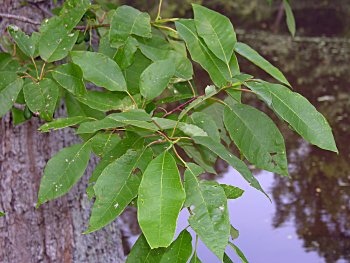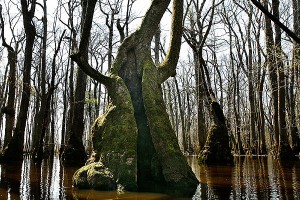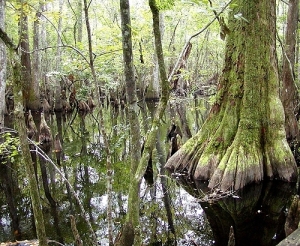Cryptobotany: NY’s Relict Aquatic Tree Species
Posted by: Loren Coleman on May 7th, 2011
There is happy springtime weather, even in the northern states, for a change. It is time to explore outside, and maybe you would like to take a cryptobotanical expedition? How about in the lower tier of New York State, along the Hudson River and surrounding watershed?
Want to search for something that won’t move around as much as a cryptid?
Here you go…
The water tupelo, Nyssa aquatica, has been found in intriguing wild (unpopulated) locations along the watershed in New York State, between the Catskills and New York City.


Nyssa aquatica
One recent visitor to the International Cryptozoology Museum, who directs the scientific research on this watershed, said that the forestry specialists are surprised by this find. It does not look as if the wild water tupelo stands were the result of landscaping or human intervention. The experts are wondering if these might be ancient groves of trees left over from the last ice age.
An official investigation is ongoing. But, guess what? No one has taken any photos of the stands yet. Will you, for Cryptomundo? Can you find the wild water tupelos, waiting for a New York-visiting photographer?
Nyssa aquatica, the Water Tupelo, Cottongum, Sourgum, Tupelo-gum, and Water-gum, is a large, long-lived tupelo tree that grows in swamps and floodplains of the Southeastern United States. They are not suppose to be in New York State, in the wild, in large stands, miles from where they might (rarely) have been in someone’s garden.
There are some remarkable collections of these trees in the USA. Tupelo gum is a long-lived tree and some of the best examples of large, old growth trees occur in the Cache River area in Illinois on land once owned by the Main brothers. This area is now an Illinois Natural Area. The cypress and tupelo gum swamps in the Cache River Nature Preserve contain trees that are 1000 years old.

This is a 1000 year old water tupelo tree Nyssa aquatica in Virginia.
The Water Tupelo Tree has a swollen base, grows large and lives a long life in Southern swamps or flood plains. The Water Tupelo Tree often may be found growing in pure stands.
But there are other mystery trees in New York.

A 1000 year old bald cypress Taxodium distichum in South Carolina.
New York’s watershed also appears to be hiding some out-of-place ancient groves of bald cypress (Taxodium distichum) near Croton-on-the-Hudson. At one time, there was a stand found on land positioned into Moodna Creek, just inside Cornwall Bay. That grove of small bald cypress trees were growing just above the reach of tidewater. They reportedly are gone now, but a couple of other groves have been sighted and found in the area. The skeptics say these are the result of estate plantings, but my insider informant is not so sure. Once again, these might be the result of a “relict population” left over from bygone days. These balds too need to be photographed!
Cryptobotany does have some interesting mysteries out there.
About Loren Coleman
Loren Coleman is one of the world’s leading cryptozoologists, some say “the” leading living cryptozoologist. Certainly, he is acknowledged as the current living American researcher and writer who has most popularized cryptozoology in the late 20th and early 21st centuries.
Starting his fieldwork and investigations in 1960, after traveling and trekking extensively in pursuit of cryptozoological mysteries, Coleman began writing to share his experiences in 1969. An honorary member of Ivan T. Sanderson’s Society for the Investigation of the Unexplained in the 1970s, Coleman has been bestowed with similar honorary memberships of the North Idaho College Cryptozoology Club in 1983, and in subsequent years, that of the British Columbia Scientific Cryptozoology Club, CryptoSafari International, and other international organizations. He was also a Life Member and Benefactor of the International Society of Cryptozoology (now-defunct).
Loren Coleman’s daily blog, as a member of the Cryptomundo Team, served as an ongoing avenue of communication for the ever-growing body of cryptozoo news from 2005 through 2013. He returned as an infrequent contributor beginning Halloween week of 2015.
Coleman is the founder in 2003, and current director of the International Cryptozoology Museum in Portland, Maine.










The only problem with Cryptobotony, all those darned Blobsquash pics.